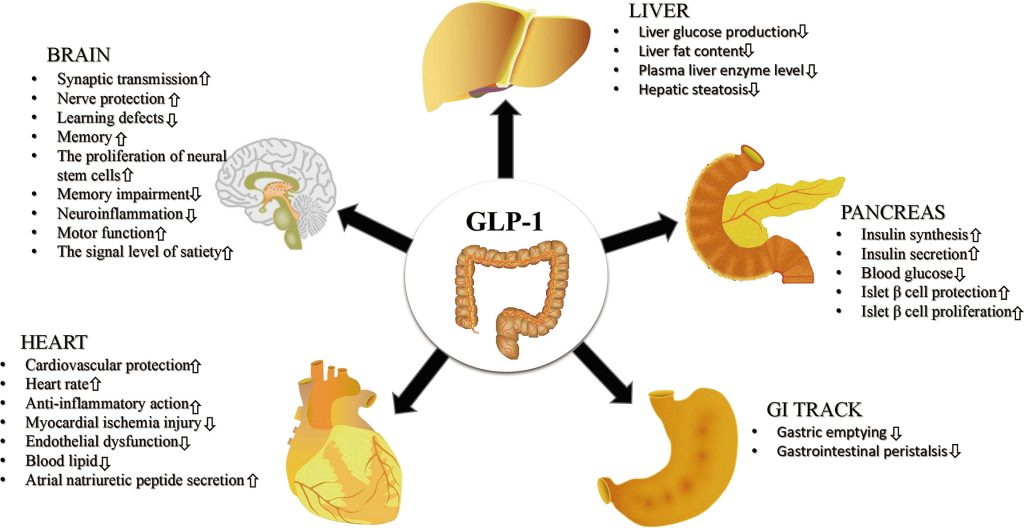
Introduction
GLP-1, or Glucagon-like peptide 1, is a crucial hormone in the human body that plays a significant role in regulating blood sugar levels, metabolism, and satiety. Understanding where and how GLP-1 is produced is essential for comprehending its impact on health and its potential therapeutic applications.
What is GLP-1?
GLP-1 is a hormone produced in the intestine, specifically in the L cells of the lower small intestine and the colon. Its primary function is to stimulate insulin release in response to food intake, thereby helping to regulate glucose levels in the bloodstream. Beyond its role in insulin secretion, GLP-1 also inhibits glucagon release, slows gastric emptying, and promotes satiety, all of which contribute to its overall metabolic effects.
Production Process of GLP-1
GLP-1 production begins with the synthesis of proglucagon in the L cells of the intestine. Proglucagon is subsequently cleaved by the enzyme prohormone convertase 1/3 (PC1/3) to produce GLP-1 and other peptides depending on the tissue type. Once released, GLP-1 exerts its effects locally within the gut and also enters the bloodstream, where it acts on various organs including the pancreas, liver, and brain.
Regulation of GLP-1 Production
The production of GLP-1 is tightly regulated by several factors, including nutrient intake, neural signals from the vagus nerve, and hormonal signals such as insulin and glucagon. Nutrient-rich meals, particularly those high in carbohydrates and fats, stimulate GLP-1 secretion to facilitate efficient glucose metabolism and nutrient absorption. For more information on how GLP-1 impacts metabolic health and to explore effective treatments, consider this GLP-1 receptor agonist. Click here to learn more and make a positive change in your health journey.
Therapeutic Applications of GLP-1
Due to its role in glucose metabolism and appetite regulation, GLP-1 has become a target for therapeutic interventions in conditions such as type 2 diabetes and obesity. Pharmaceuticals known as GLP-1 receptor agonists mimic the effects of GLP-1, promoting insulin secretion and weight loss. These drugs are administered subcutaneously and have shown efficacy in improving glycemic control and reducing body weight in patients with metabolic disorders.
Future Directions and Research
Ongoing research continues to explore the potential of GLP-1 and its analogs in treating other metabolic conditions beyond diabetes and obesity. Novel delivery methods, such as oral formulations and sustained-release technologies, aim to enhance patient compliance and therapeutic outcomes. Additionally, investigations into the broader physiological roles of GLP-1, including its effects on cardiovascular health and neuroprotection, offer promising avenues for future therapeutic development.
Conclusion
In summary, GLP-1 is a critical hormone produced in the intestine that plays a key role in regulating blood sugar levels and metabolism. Its production is influenced by nutrient intake and hormonal signals, making it essential for maintaining metabolic balance. Therapeutically, GLP-1 receptor agonists offer promising treatments for conditions like diabetes and obesity. Continued research into GLP-1’s broader impacts holds potential for future advancements in metabolic health.
FAQs
1. What stimulates the production of GLP-1?
GLP-1 production is primarily stimulated by nutrient intake, especially carbohydrates and fats, which trigger secretion from intestinal L cells.
2. How does GLP-1 regulate blood sugar levels?
GLP-1 stimulates insulin release from pancreatic beta cells in response to elevated blood glucose levels, helping to maintain glucose homeostasis.
3. What are GLP-1 receptor agonists?
GLP-1 receptor agonists are medications that mimic the effects of GLP-1, promoting insulin secretion and reducing appetite to aid in the management of diabetes and obesity.
4. Can GLP-1 be used as a treatment for conditions other than diabetes?
Research suggests potential applications of GLP-1 in cardiovascular health and neuroprotection, though further studies are needed to establish its efficacy in these areas.
5. How is GLP-1 regulated in the body?
GLP-1 production is regulated by neural signals from the vagus nerve, hormonal signals such as insulin and glucagon, and nutrient intake.